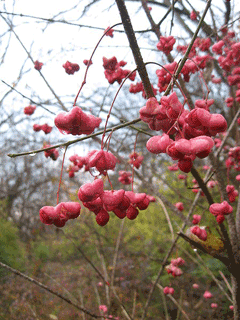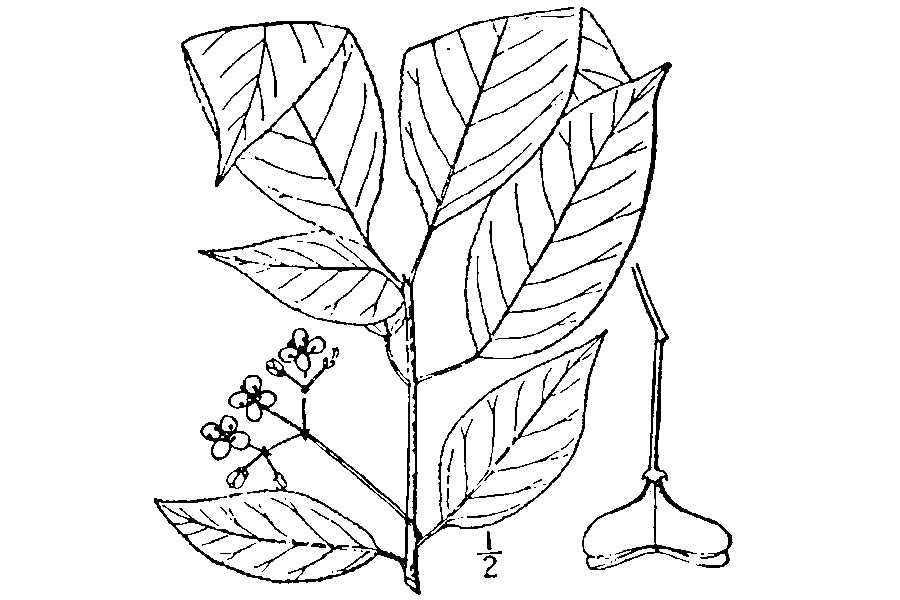 |
|
http://en.wikipedia.org/wiki/User:Masebrock |
 |
| USDA-NRCS PLANTS Database / Britton, N.L., and A. Brown. 1913. An illustrated flora of the northern United States, Canada and the British Possessions. Vol. 2: 491. |
Translate this page:
Summary
Physical Characteristics

 Euonymus atropurpureus is a deciduous Shrub growing to 2.5 m (8ft 2in) at a medium rate.
Euonymus atropurpureus is a deciduous Shrub growing to 2.5 m (8ft 2in) at a medium rate.
See above for USDA hardiness. It is hardy to UK zone 4. It is in flower in June, and the seeds ripen in October. The species is hermaphrodite (has both male and female organs) and is pollinated by Insects.
Suitable for: light (sandy), medium (loamy) and heavy (clay) soils. Suitable pH: mildly acid, neutral and basic (mildly alkaline) soils. It can grow in semi-shade (light woodland) or no shade. It prefers dry or moist soil.
UK Hardiness Map
US Hardiness Map
Synonyms
Euonymus caroliniensis Marshall. Euonymus latifolius Marshall. Euonymus tristis Salisb.
Plant Habitats
Woodland Garden Dappled Shade; Shady Edge;
Edible Uses
Edible Parts: Fruit
Edible Uses:
Although the fruit has sometimes been eaten, it is considered to be poisonous by some writers and so should definitely be avoided[213]. The fruit is about 15mm in diameter[200].
References More on Edible Uses
Medicinal Uses
Plants For A Future can not take any responsibility for any adverse effects from the use of plants. Always seek advice from a professional before using a plant medicinally.
Alterative Cardiac Cathartic Cholagogue Diuretic Eczema Emetic Expectorant
Hepatic Malaria Tonic
Wahoo was used in various ways by the North American Indians, for example as an eye lotion, as a poultice for facial sores and for gynaecological conditions[254]. In current herbalism it is considered to be a gallbladder remedy with laxative and diuretic properties[254]. The bark, however, is toxic and should only be used under professional supervision, it should not be given to pregnant women or nursing mothers[254]. The stem and root bark is alterative, cardiac, cathartic, cholagogue, diuretic, expectorant, hepatic, laxative, stimulant and tonic[4, 21, 46, 61, 222]. The root bark is the part normally used, though bark from the stems is sometimes employed as a substitute[4]. In small doses it stimulates the appetite, in larger doses it irritates the intestines[4]. The bark is especially useful in the treatment of biliousness and liver disorders which follow or accompany fevers[4, 254] and for treating various skin disorders such as eczema which could arise from poor liver and gallbladder function[254]. It is also used as a tea in the treatment of malaria, liver congestion, constipation etc[222]. The powdered bark, applied to the scalp, was believed to eliminate dandruff[222]. The bark and the root contain digitoxin and have a digitalis-like effect on the heart[213, 222]. They have been used in the treatment of heart conditions[254]. The bark, which has a sweetish taste, is gathered in the autumn and can be dried for later use[213]. A tea made from the roots is used in cases of uterine prolapse, vomiting of blood, painful urination and stomach-aches[222]. The seed is emetic and strongly laxative[222].
References More on Medicinal Uses
The Bookshop: Edible Plant Books
Our Latest books on Perennial Plants For Food Forests and Permaculture Gardens in paperback or digital formats.

Edible Tropical Plants
Food Forest Plants for Hotter Conditions: 250+ Plants For Tropical Food Forests & Permaculture Gardens.
More

Edible Temperate Plants
Plants for Your Food Forest: 500 Plants for Temperate Food Forests & Permaculture Gardens.
More

More Books
PFAF have eight books available in paperback and digital formats. Browse the shop for more information.
Shop Now
Other Uses
Wood
Wood - heavy, hard, tough, very close grained[82, 227]. It weighs 41lb per cubic foot[227], but is too small to be of commercial value[229].
Special Uses
References More on Other Uses
Cultivation details
Thrives in almost any soil, including chalk, it is particularly suited to dry shaded areas[200]. Prefers a well-drained loamy soil[1]. Requires shade from the midday sun[1, 11]. A moderately fast-growing but short-lived tree in the wild[229].
References Carbon Farming Information and Carbon Sequestration Information
Temperature Converter
Type a value in the Celsius field to convert the value to Fahrenheit:
Fahrenheit:
The PFAF Bookshop
Plants For A Future have a number of books available in paperback and digital form. Book titles include Edible Plants, Edible Perennials, Edible Trees,Edible Shrubs, Woodland Gardening, and Temperate Food Forest Plants. Our new book is Food Forest Plants For Hotter Conditions (Tropical and Sub-Tropical).
Shop Now
Plant Propagation
Seed - best sown as soon as it is ripe in a cold frame. Stored seed requires 8 - 12 weeks warm followed by 8 - 16 weeks cold stratification and can then be sown in a cold frame[78, 98]. When they are large enough to handle, prick the seedlings out into individual pots and grow them on in the greenhouse for at least their first winter. Plant them out into their permanent positions in late spring or early summer, after the last expected frosts. Cuttings of half-ripe wood, 5 - 8cm long taken at a node or with a heel, July/August in a frame. Very easy[200].
Other Names
If available other names are mentioned here
Native Range
NORTHERN AMERICA: Canada (Ontario (south)), United States (Connecticut, Indiana, Massachusetts, Michigan (south), New Hampshire, New Jersey, Ohio, Pennsylvania, Rhode Island, West Virginia, Illinois, Iowa, Kansas (east), Minnesota (south), Missouri, Nebraska (east), North Dakota (southeast), Oklahoma, South Dakota (east), Wisconsin, Alabama (north & central), Arkansas, Delaware, Florida (Gadsden Co.), Georgia, Kentucky, Maryland, Mississippi, North Carolina, South Carolina, Tennessee, Virginia, Texas)
Weed Potential
Right plant wrong place. We are currently updating this section.
Please note that a plant may be invasive in one area but may not in your area so it's worth checking.
Conservation Status
IUCN Red List of Threatened Plants Status :

Growth: S = slow M = medium F = fast. Soil: L = light (sandy) M = medium H = heavy (clay). pH: A = acid N = neutral B = basic (alkaline). Shade: F = full shade S = semi-shade N = no shade. Moisture: D = dry M = Moist We = wet Wa = water.
Now available:
Food Forest Plants for Mediterranean Conditions
350+ Perennial Plants For Mediterranean and Drier Food Forests and Permaculture Gardens.
[Paperback and eBook]
This is the third in Plants For A Future's series of plant guides for food forests tailored to
specific climate zones. Following volumes on temperate and tropical ecosystems, this book focuses
on species suited to Mediterranean conditions—regions with hot, dry summers and cool, wet winters,
often facing the added challenge of climate change.
Read More
Expert comment
Author
Jacq.
Botanical References
1143200
Links / References
For a list of references used on this page please go here
Readers comment
| Add a comment |
|
If you have important information about this plant that may help other users please add a comment or link below. Only comments or links that are felt to be directly relevant to a plant will be included. If you think a comment/link or information contained on this page is inaccurate or misleading we would welcome your feedback at [email protected]. If you have questions about a plant please use the Forum on this website as we do not have the resources to answer questions ourselves.
* Please note: the comments by website users are not necessarily those held by PFAF and may give misleading or inaccurate information.
To leave a comment please Register or login here All comments need to be approved so will not appear immediately.
|
Subject : Euonymus atropurpureus
|
|
|
|